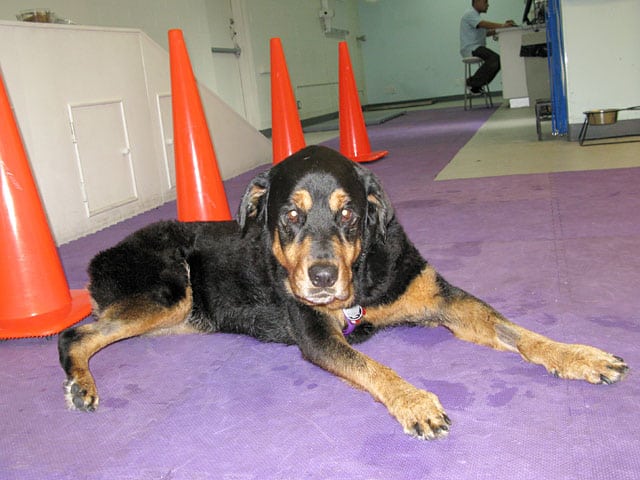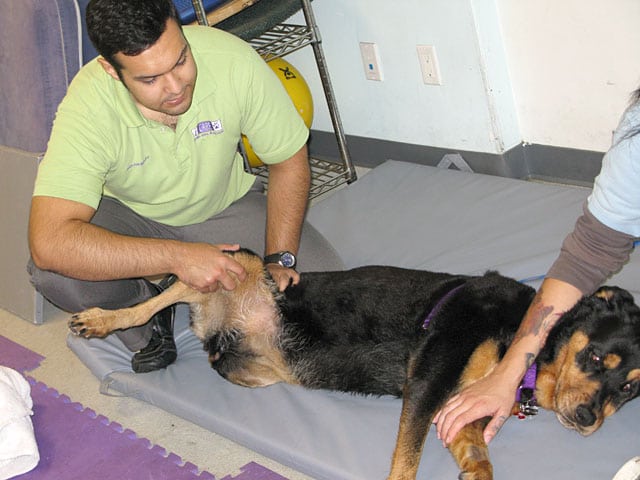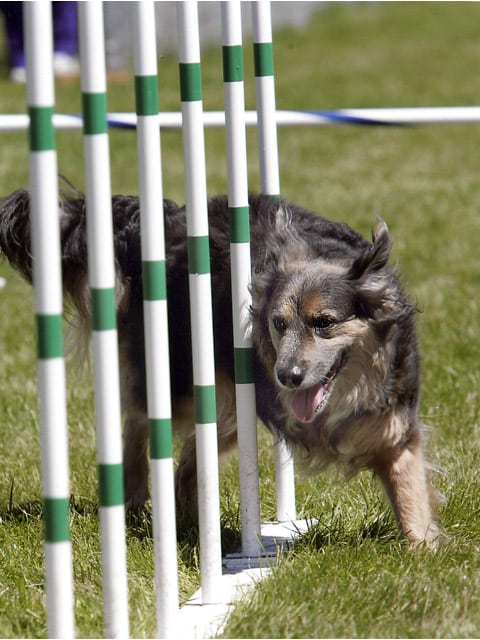Lucy is an older Tripawd rottweiler who lost her rear left leg to osteosarcoma in July 2010.
 As a large breed dog with bad elbows and two previous bi-lateral TPLO surgeries, Lucy might have appeared to be a poor candidate for amputation to some people.
As a large breed dog with bad elbows and two previous bi-lateral TPLO surgeries, Lucy might have appeared to be a poor candidate for amputation to some people.
But her parent, Dr. Amy Kramer, knew better.
Amy Kramer, PT, DPT, CCRT, is co-founder of California Animal Rehabilitation in Los Angeles. Her extensive background in human and animal rehabilitation gave her the confidence she needed to proceed with Lucy’s amputation after the diagnosis.
Nearly one year after her amputation, Lucy is beating the odds and thriving, especially thanks to her twice-weekly canine physical therapy workouts at CARE.
Lucy’s Rear Leg Workout Routine
In this video, Lucy demonstrates a few workout tips for us, along with therapy assistant Catherine Shields. After her morning hydrotherapy session, Lucy performs a series of reaching stretches, weight shifts, pole weaving and abdominal crunches to gain flexibility, strengthen her core muscles, and improve her proprioception (body awareness). Keep reading below for a written outline of Lucy’s workout.
[youtube]http://www.youtube.com/watch?v=-BreTm7a7SQ[/youtube]
Reaching Stretches
Lucy has just had a water workout, so Catherine is gently supporting her remaining rear leg by allowing Lucy’s rear end to balance on Catherine’s thigh.
To promote better flexibility in the shoulders and sides, and to alleviate neck and upper back pain, Catherine is using treats to have Lucy perform range of motion exercises such as:
- Turn her head and make wide side-to-side torso movements
- Look up in a “chest-to-sky” movement
Reaching stretches are often called “cookie stretches,” but we recommend using fruit, carrots or green beans as treats to help avoid weight gain.
Weight Shifts
 Lucy performs weight shifts to help strengthen her back muscles and encourage weight bearing on her remaining rear leg.
Lucy performs weight shifts to help strengthen her back muscles and encourage weight bearing on her remaining rear leg.
Dog weight shift exercises are similar to how you would balance yourself when walking on a floating dock: as the dock bobs around on the water, you must adjust your balance and weight to keep from toppling over.
Catherine demonstrates weight shifts by gently putting pressure on one side of Lucy’s hips and then the other.
Weight shifts are explained in detail by Darryl L. Millis, MS, DVM, Diplomate ACVS, CCRP Professor of Orthopedic Surgery at the University of Tennessee College of Veterinary Medicine. He says:
“The goal is to disturb its balance just enough so the animal can recover, being careful not to push too hard.”
Dr. Millis advises that “weight shifts may also be performed during walking. As the animal is walked, the handler gently bumps or pushes the animal to one side. Caution should be used to avoid falls and injury.”
Weaving
 Agility dog Maggie can tell you, weaving is so much fun it doesn’t seem like a workout. Weaving helps improve a dog’s reaction and control, increase trunk and core strength and stabilize weak areas. Weaving also improves balance and awareness of the body’s position in space.
Agility dog Maggie can tell you, weaving is so much fun it doesn’t seem like a workout. Weaving helps improve a dog’s reaction and control, increase trunk and core strength and stabilize weak areas. Weaving also improves balance and awareness of the body’s position in space.
You can use a traditional agility weaving set with poles or cones or line up simple obstacles found in your home. Weaving works like this:
- The handler slowly tempts the dog to follow her hand movements with a treat.
- The dog simply follows her nose by weaving in and out of the cones and back again.
- A beginner workout should consist of weaving between four to six cones or poles (depending on your Tripawd’s energy level)
- Eventually you can work up to 12 weaving obstacles.
Remember to take it slow and if your dog sits down or doesn’t want to do anymore weaves, your dog is probably tired, so stop.
Dog Abdominal Crunches
Gentle abdominal crunches for canines work the same way oblique (side) crunches do for humans. Catherine explains that canine abdominal crunches help to build abdominal strength which better supports a dog’s weight and promotes flexibility.
Canine abdominal crunches for dogs are performed by:
- Having the dog lay on one side
- Bring a treat to the dog’s nose and slowly move your hand down the length of the dog’s body to the groin area
- Release the treat and repeat a few more times depending on your dog’s fitness level
- Repeat on other side
Watch for Fatigue
These are just a few basic exercises you can do on your own to help your rear legged tripod. During your dog’s workout, watch for subtle signs of fatigue that can include:
- Lip licking
- Uneven breathing
- Panting
- Staring at you
- Sitting down
- Refusing to move
If your dog is exhibiting these behaviors, stop and praise your dog for a job well done!
We highly recommend contacting a certified canine rehabilitation specialist like CARE who can help you build a complete home workout routine and get your Tripawd into the best shape pawsible.
Many thanks to everyone at California Animal Rehabilitation in Los Angeles for helping us bring this series to you. If you are lucky enough to live nearby, be sure to visit their facility and see how staff can help your canine amputee stay strong and live hoppy!
Recommended Reading and Resources
Cookie Stretches: Learn additional ways of performing these beneficial movements at AgilityNerd.com.
Exercises to Enhance Proprioception by Darryl L. Millis, MS, DVM, Diplomate ACVS, CCRP Professor of Orthopedic Surgery at the University of Tennessee College of Veterinary Medicine.
See all of our three legged dog rehabilitation videos with CARE.
I have a question :
My tripaw is a border collie, also hind leg amputated due to a motor accident. She is highly energetic and this obviously comes out as aggression. She is only allowed limited running due to her remaining hind leg having a hairline fracture. I live in South Africa and there is no nearby town that has someone who does hydrotherapy. Is there anything else that I could do with her?
Yes! See if you have any certified canine rehab vets/techs near you. A CCRT/CCRP can prescribe various exercises just for your dog that you can do at home. Or, consider downloading Loving Life On Three Legs which is filled with many tips, stretches, and core conditioning exercise articles, videos and podcasts.
Above all eliminate any running and other “explosive” exercise, especially with any sort of fracture! There are many weight bearing, balance and strengthening exercises you can do at home.
This is a fantastic blog entry and just the information I was looking for in regards to some exercises we can eventually start doing at home.
Thank you, Tripawds!!!!!
Aww thanks! Be sure to check out Loving Life on Three Legs for lots more!
Another THREE PAWS UP! for a great blog!!! 🙂 Great information! Thanks to Tripawds and CARE for the continued rehab blogs! Love ’em!
Tracy & Maggie